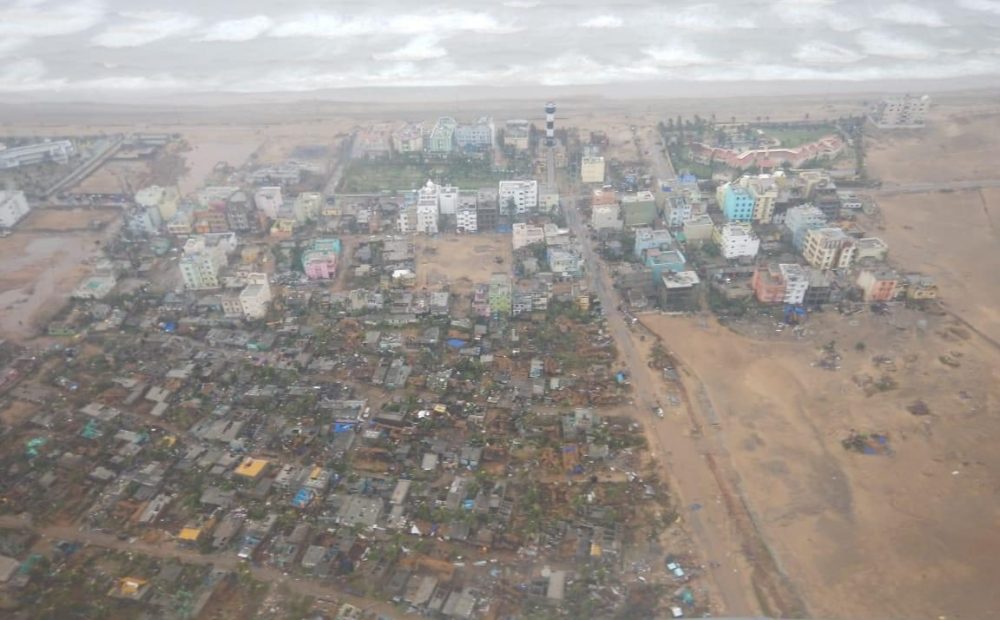
Last updated:
Cyclone Fani

Overview
Cyclone Fani, the worst cyclone to hit India in decades, made landfall in the morning on Friday, May 3, near the city of Puri in Odisha state, India.
Winds were as high as 120-130 mph and the storm was the equivalent of a Category 4 hurricane. The storm then traveled through India to Kolkata and on to Bangladesh. There were 77 deaths reported; 13 in Bangladesh and 64 in India, the majority of which (39) were in Puri. There was also significant concern before landfall for the nearly one million Rohingya refugees who have fled ethnic violence in Myanmar and are now living in coastal refugee camps in Bangladesh. UNHCR in Bangladesh worked hard to make the camps safer and to pre-position emergency supplies, but many of the makeshift shelters were washed away.
There has been significant focus since the cyclone on the effectiveness of the evacuation and the impact it had on reducing deaths. The majority of the world’s deadliest tropical cyclones have struck India and/or Bangladesh. This includes the Great Orissa/Odisha Cyclone of 1999 (Odisha used to be known as Orissa and the storm is alternatively referred to by one or the other) which killed 9,000-10,000 people in October 1999. The India Meteorological Department (IMD) is being praised for its notifications, tracking and response to Fani. It is likely that IMD’s efforts, which led to more than one million people evacuating from India’s east coast and 1.2 million people evacuating in Bangladesh, helped save lives.
(Photo: Aerial photos show massive damage from Cyclone Fani in Puri, India. Source: Indian Navy)
However, this praise for evacuation successes and the corresponding minimal loss of life, has resulted in a lack of understanding of the severity of the impacts of the storm. There was significant damage to homes, resulting in hundreds of thousands of people taking refuge in relief camps. There was also a major impact on the farming, fishing and agricultural industries including: destroyed crops, missing or killed livestock and loss of fishing boats and nets. The coastal area of India has a primary coconut industry and full-grown trees were torn from their roots.
What is the impact on communities?
- 508,467 houses were damaged in India alone. In Puri, 189,095 kutcha (temporary thatch houses) were damaged. In Bangladesh about 13,000 homes were damaged or destroyed.
- Nearly 38 million livestock were killed (mostly poultry) in India.
- Significant damage to electrical infrastructure and telecom towers.
- Summer crops, orchards and plantations were devastated on a large scale. Nearly 400,000 acres of agricultural area have been affected in India and 155,832 acres in Bangladesh.
- 1,031 public health facilities were damaged.
- Nearly 7,000 school buildings were damaged.
- 980.69 km. of river/saline embankments
As a result of the large amount of displacement, ongoing needs include:
- Food and nutritional supplies
- Water and sanitation
- Medical supplies and personnel
- Emergency shelter
- Fuel, electricity, communications technology and other infrastructure needs
- Rebuilding of schools, homes and public infrastructure
In all disasters, but particularly in international disasters, cash donations are recommended by disaster experts as they allow for on-the-ground agencies to direct funds to the greatest area of need, to support economic recovery and to ensure that donations management does not take away from disaster recovery needs.
While we recognize the importance of the urgent and critical needs in a disaster, experience has shown us that long-term recovery needs, such as housing and economic development, will be present for months and years to come
CDP launched the CDP Global Recovery Fund, an exclusive fund to meet the ongoing and ever-expanding challenges presented by international disasters, learn more.
Contact CDP
Recovery updates
If you are a responding NGO or a donor, please send updates on how you are working on recovery from this disaster to Tanya Gulliver-Garcia.
Donor recommendations
If you are a donor looking for recommendations on how to help with disaster recovery, please email Regine A. Webster.
Philanthropic and government support
While CDP does not currently recommend any specific nonprofits, we do encourage donors to consider the following before supporting any organization:
- Does the organization have a pre-existing relationship in the affected country? This can include working in previous disasters or ongoing program delivery.
- Does the organization have staff on the ground, including locals who provide cultural, technical and geographic knowledge of the communities and their needs?
- Has the government requested international assistance and is the organization working through the proper channels (not self-deploying)?
- Does the organization have a disaster response history and/or provide a necessary service needed in a specific disaster? While a nonprofit may expand the scope of its work to meet communities’ needs, it should not be trying to change its mandate to take financial advantage of the disaster.
CDP has also created a list of suggestions for foundations to consider related to disaster giving. These include:
Take the long view: Even while focusing on immediate needs, remember that it will take some time for the full range of needs to emerge. Be patient in planning for disaster funding. Recovery will take a long time, and funding will be needed throughout.
Recognize there are places private philanthropy can help that government agencies might not: Private funders have opportunities to develop innovative solutions to help prevent or mitigate future disasters that the government cannot execute.
All funders are disaster philanthropists: Even if your organization does not work in a particular geographic area or fund immediate relief efforts, you can look for ways to tie disaster funding into your existing mission. If you focus on education, health, children or vulnerable populations, disasters present prime opportunities.
Ask the experts: If you are considering supporting an organization that is positioned to work in an affected area, do some research. InterAction has information about organizations working in affected communities.
We welcome republication of our content. Please credit the Center for Disaster Philanthropy.